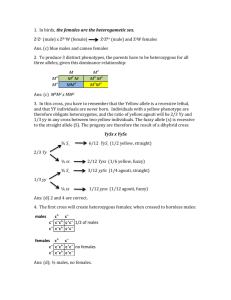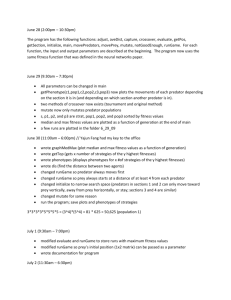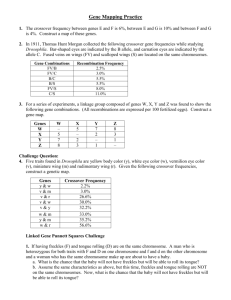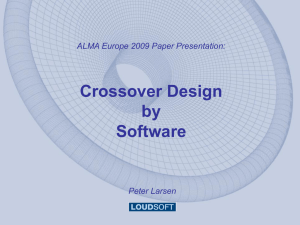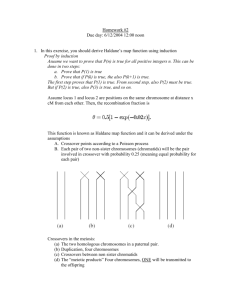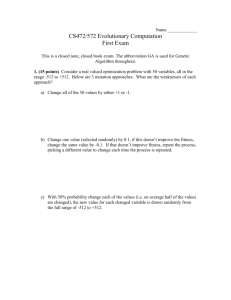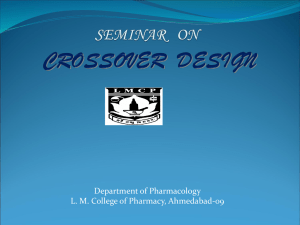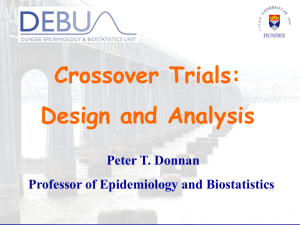single fig
advertisement
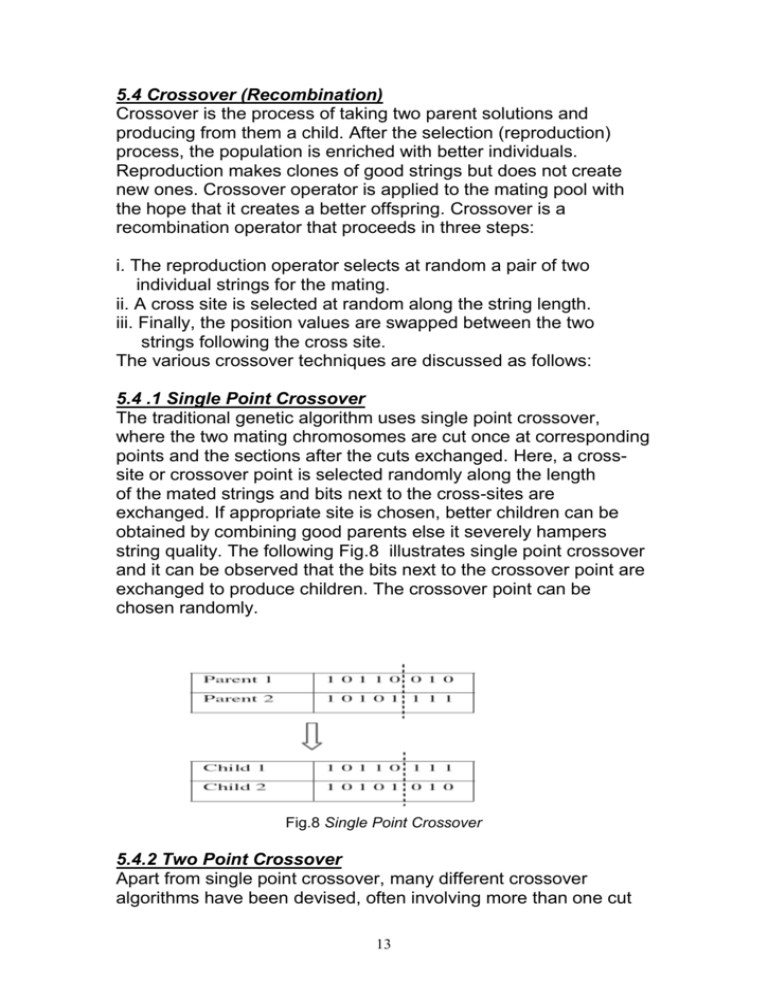
5.4 Crossover (Recombination)
Crossover is the process of taking two parent solutions and
producing from them a child. After the selection (reproduction)
process, the population is enriched with better individuals.
Reproduction makes clones of good strings but does not create
new ones. Crossover operator is applied to the mating pool with
the hope that it creates a better offspring. Crossover is a
recombination operator that proceeds in three steps:
i. The reproduction operator selects at random a pair of two
individual strings for the mating.
ii. A cross site is selected at random along the string length.
iii. Finally, the position values are swapped between the two
strings following the cross site.
The various crossover techniques are discussed as follows:
5.4 .1 Single Point Crossover
The traditional genetic algorithm uses single point crossover,
where the two mating chromosomes are cut once at corresponding
points and the sections after the cuts exchanged. Here, a crosssite or crossover point is selected randomly along the length
of the mated strings and bits next to the cross-sites are
exchanged. If appropriate site is chosen, better children can be
obtained by combining good parents else it severely hampers
string quality. The following Fig.8 illustrates single point crossover
and it can be observed that the bits next to the crossover point are
exchanged to produce children. The crossover point can be
chosen randomly.
Fig.8 Single Point Crossover
5.4.2 Two Point Crossover
Apart from single point crossover, many different crossover
algorithms have been devised, often involving more than one cut
13
point. It should be noted that adding further crossover points
reduces the performance of the GA. The problem with adding
additional crossover points is that building blocks are more likely to
be disrupted. However, an advantage of having more crossover
points is that the problem space may be searched more
thoroughly. In two-point crossover, two crossover points are
chosen and the contents between these points are exchanged
between two mated parents.
In the following Fig. 9 the dotted lines indicate the crossover
points. Thus the contents between these points are exchanged
between the parents to produce new children for mating in the next
generation.
Fig.9 two Point Crossover
5.4.3 Multi-Point Crossover (N-Point crossover)
There are two ways in this crossover. One is even number of
cross-sites and the other odd number of cross-sites. In the case of
even number of cross-sites, cross-sites are selected randomly
around a circle and information is exchanged. In the case of odd
number of cross-sites, a different cross-point is always assumed at
the string
beginning.
5.4.4 Uniform Crossover
Uniform crossover is quite different from the N-point crossover.
Each gene in the offspring is created by copying the corresponding
gene from one or the other parent chosen according to a random
generated binary crossover mask of the same length as the
chromosomes. Where there is a 1 in the crossover mask, the gene
is copied from the first parent, and where there is a 0 in the mask
14
the gene is copied from the second parent. A new crossover mask
is randomly generated for each pair of parents. Offsprings,
therefore contain a mixture of genes from each parent. The
number of effective crossing point is not fixed, but will average L/2
(where L is the
chromosome length).In Fig. 10, new children are produced using
uniform crossover approach. It can be noticed, that while
producing child 1, when there is a 1 in the mask, the gene is
copied from the parent 1 else from the parent 2. On producing
child 2, when there is a 1 in the mask, the gene is copied from
parent 2, when there is a 0 in the mask; the gene is copied from
the parent 1.
Fig.10 uniform Crossover
5.4.5 Three Parent Crossover
In this crossover technique, three parents are randomly chosen.
Each bit of the first parent is compared with the bit of the second
parent. If both are the same, the bit is taken for the offspring
otherwise; the bit from the third parent is taken for the
offspring. This concept is illustrated in Fig.11
Fig.11 three parent Crossover
5.4.6 Precedence Preservative Crossover (PPX)
PPX was independently developed for vehicle routing problems by
Blanton and Wainwright (1993) and for scheduling problems by
15
Bierwirth et al. (1996). The operator passes on precedence
relations of operations given in two parental permutations
to one offspring at the same rate, while no new precedence
relations are introduced. PPX is illustrated in below, for a problem
consisting of six operations A–F.
The operator works as follows:
• A vector of length Sigma, sub i=1to mi, representing the number
of operations involved in the problem, is randomly filled with
elements of the set {1, 2}.
• This vector defines the order in which the operations are
successively drawn from parent 1 and parent 2.
• We can also consider the parent and offspring permutations as
lists, for which the operations ‘append’ and ‘delete’ are defined.
• First we start by initializing an empty offspring.
• The leftmost operation in one of the two parents is selected in
accordance with the order of parents given in the vector.
• After an operation is selected it is deleted in both parents.
• Finally the selected operation is appended to the offspring.
• This step is repeated until both parents are empty and the
offspring contains all operations involved.
• Note that PPX does not work in a uniform-crossover manner due
to the ‘deletion append’ scheme used.
Example is shown in Fig.12
Fig.12 PPX Crossover
5.4.7 Ordered Crossover
Ordered two-point crossover is used when the problem is of order
based, for example in U-shaped assembly line balancing etc.
Given two parent chromosomes, two random crossover points are
selected partitioning them into a left, middle and right portion. The
ordered two-point crossover behaves in the following way: child 1
inherits its left and right section from parent 1, and its middle
section is determined
16
by the genes in the middle section of parent 1 in the order in which
the values appear in parent 2. A similar process is applied to
determine child 2. This is shown in Fig.13
Fig.13 ordered Crossover
5.4.8 PartiallyMatched Crossover (PMX)
PMX can be applied usefully in the TSP. Indeed, TSP
chromosomes are simply sequences of integers, where each
integer represents a different city and the order represents the time
at which a city is visited. Under this representation, known as
permutation encoding, we are only interested in labels . It may be
viewed as a crossover of permutations that guarantees that all
positions are found exactly once in each offspring, i.e. both
offspring receive a full complement of genes, followed by the
corresponding filling in of alleles from their parents.
PMX proceeds as follows:
1. The two chromosomes are aligned.
2. Two crossing sites are selected uniformly at random along the
strings, defining a matching section
• The matching section is used to effect a cross through positionby-position exchange operation
• Alleles are moved to their new positions in the offspring
• The following illustrates how PMX works.
• Consider the two strings shown in Fig. 3.14
• Where, the dots mark the selected cross points.
• The matching section defines the position-wise exchanges that
must take place in both parents to produce the offspring.
• The exchanges are read from the matching section of one
chromosome to that of the other.
• In the example, the numbers that exchange places are 5 and 2, 6
and 3, and 7 and 10.
• The resulting offspring are as shown in Fig. 3.14
17
Fig.14 PMX Crossover
18

